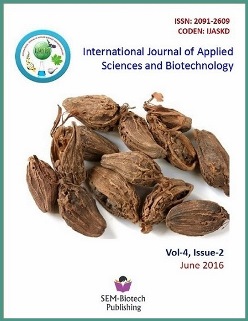Vibriosis in Farm Reared White Shrimp, Litopenaeus Vannamei in Andhra Pradesh-Natural Occurrence and Artificial Challenge
DOI:
https://doi.org/10.3126/ijasbt.v4i2.15126Keywords:
Shrimp, infection, vibriosis, bacteriaAbstract
In the present study, a total of five species of Vibrio bacteria were isolated from diseased shrimp, Litopenaeus vannamei, collected from commercial shrimp cultured ponds of Eethamukkala, Chinaganjam and Pedaganjam areas, Prakasam district, Andhra Pradesh. The isolated bacterial species were identified as Vibrio parahaemolyticus, Vibrio harveyi, Vibrio alginolyticus, Vibrio mimicus and Vibrio vulnificus. The symptoms shown by diseased shrimps include loss of appetite, red coloration of the body and pleopods, gills often appear red to brown in colour, reduced feeding, empty gut and general septicemia. In diseased shrimp, hepatopancrocytes may appear poorly vacuolated, indicating low lipid and glycogen reserve. In affected shrimps, localized lesions were also observed in the cuticle. Experimental infection trials reveals that V. parahaemolyticus is highly pathogenic to L. vannamei while V. harveyi found to be moderate pathogenic to challenged shrimp and remaining three bacterial species namely V.alginolyticus, V.mimicus and V.vulnificus were less pathogenic in nature.
Int J Appl Sci Biotechnol, Vol 4(2): 217-222




